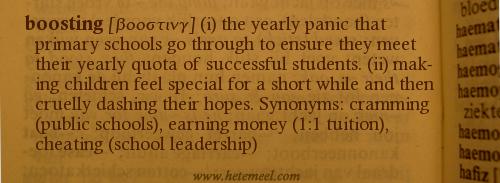 I’ve often heard it argued that learning maths is like learning another language. There is a whole vocabulary and a way of speaking that is alien to people who don’t live in the land of maths. Abstract concepts are understood by saying things that only maths people understand. The conjunction is the equals sign; verbs are operators; a degree-level literature essay is a second-order differential equation.
I’ve often heard it argued that learning maths is like learning another language. There is a whole vocabulary and a way of speaking that is alien to people who don’t live in the land of maths. Abstract concepts are understood by saying things that only maths people understand. The conjunction is the equals sign; verbs are operators; a degree-level literature essay is a second-order differential equation.
If that’s true, then Fraction County is the kind of place where the banjo stops playing when you walk into a bar. The talking stops. The locals all put down their home-made moonshine and all that can be heard is the faint rustle of tumbleweed blowing along the street outside. And you realise that the language they were talking is a completely different dialect from one that you’ve understood before.
It is no wonder that many children panic when they hear the word “fraction”.
Think about this.
The children walk into a room and see ¼ written on the board. The teacher asks “how do you say this?”
A brave child sticks their hand up and says “one line four”. Another child, emboldened by the first contribution, suggests “one point four”. Then someone asks “is it a fourth?”
“That’s not exactly how we say it,” corrects the teacher, obliquely referring to some shadowy group of people the children have never heard of. A group of people that obviously can already speak ‘Fraction’. “We say ‘quarter’” The teacher smiles reassuringly, but inside is concerned. She knows that the children should already be able to read and say a quarter and she utters a silent curse at the children’s previous teacher.
The lesson continues. The children learn that fractions are something to do with pizza (or if you listen to Sal Khan, pie). Then, after seeing that ¼ of a pizza is one piece out of 4, the teacher holds up 4 multilink cubes that are all joined together in a small tower. She asks the children how many cubes are in the tower. The children say “four”. The teacher breaks off a cube. She asks how many cubes she broke off. The children say “one”. “Ah, but what fraction did I break off?” asks the teacher, with an air of mystery. “Half?” asks a child. “A third?” asks another.
Ever patient, the teacher persists. “How many cubes were in the tower?”
“Four.”
“So what is the ‘out of’ number?”
“Four.”
“So this cube is one out of four,” declares the teacher triumphantly, writing ¼ on the board again. “How do we say that?”
“One line four” says a child.
“One four” says another.
“Quarter” says a third.
“Yes,” says the teacher, pouncing on the learning. She vigorously shakes the child in sheer joy that someone has got it. “And we write a quarter, one over four.”
The problem is in the language. The children have already learned that division is one word that means two different things – sharing and grouping. Now there’s the whole same thing going on with fractions. They’re sharing pizzas and calling each piece a fraction. Then they’re grouping sets of objects into equal subsets and calling each subset a fraction. Then despite the fraction being called “a quarter”, the teacher describes it as being “one out of four” whilst explaining that you write it “one over four.” The concepts behind these aren’t impossible to grasp, but the language we use to describe them is just so inefficient.
This is one of the reasons that my favourite thing to come out of the old National Numeracy Strategy was the book on maths vocabulary – describing the kind of words that children should be taught in each subsequent year.
But knowing the words is only part of the problem. I know some French words and some Spanish words but (to my shame) I find it hard to put them in the right order. The language of ‘Fraction’ is similar. It takes practice and good teaching to put them in order. If your teacher is woolly in their teaching and you don’t practice enough, you won’t learn the language. Worse, I know plenty of people whose maths teacher lost patience with them during some maths lesson or the other and shouted at them for not getting it quickly enough. This is often a reflection on that teacher’s subject knowledge, not the maths ability of the student. It is a reason why I recommend Derek Haylock’s excellent book on teaching maths.
So next time you’re on the road to Fraction County, make sure you’ve rehearsed some of your lines – you may just teach your child to know their denominators from their numerators.




